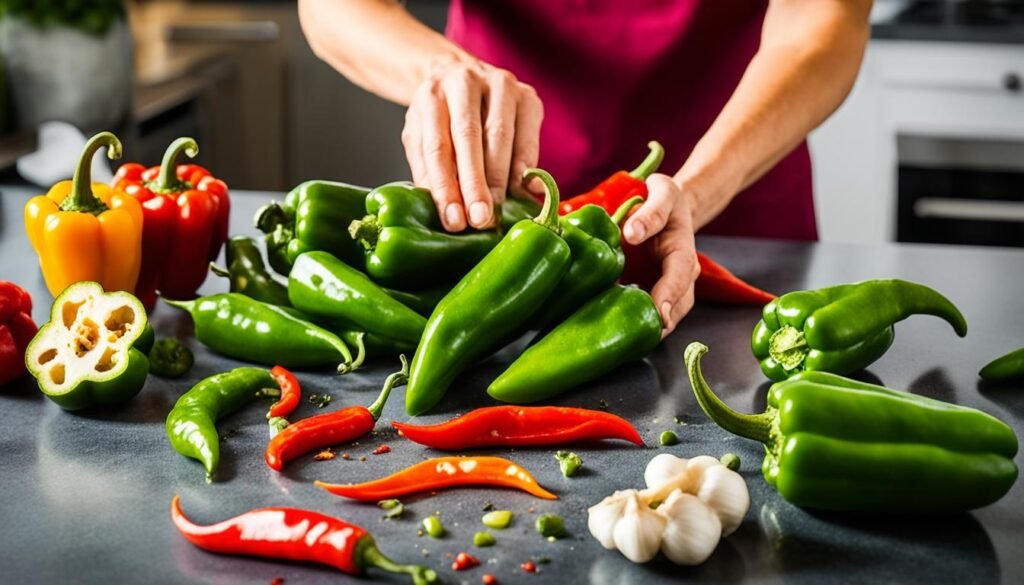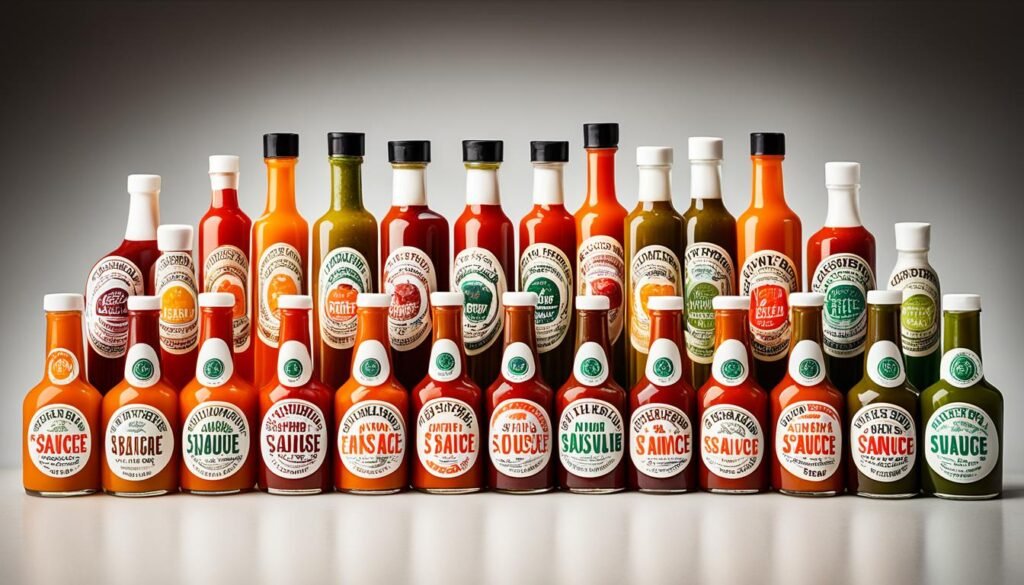Are you ready to travel into the spicy world of SIANG JI ASIA SAUCE Types of Hot Sauce? From the sharp tang of Louisiana types to the fruity heat of Caribbean options, hot sauces offer endless flavors to explore. Each Types of Hot Sauce has its own special features. How do you choose the best one for you? Let’s learn about the deep history and colorful culture of these spicy sauces.
Key Takeaways
- Discover the diverse Types of Hot Sauce varieties, each with its own distinct flavor profile and heat level.
- Explore the fascinating history and cultural significance of hot sauces around the world.
- Learn how to identify the unique characteristics and ingredients that define different Types of Hot Sauce.
- Gain insights into the art of pairing hot sauces with your favorite dishes to enhance the overall dining experience.
- Uncover the latest trends and innovations in the thriving hot sauce industry.
Types of Hot Sauce – The Spicy Origins of Hot Sauce
Hot sauce’s story goes way back to Central America’s ancient cultures. The Aztecs, Incans, and Mayans were the first to grow chile peppers. Archaeologists found chile peppers from as far back as 7000 BC. This shows these cultures really liked growing and eating spicy things. As time passed, chile peppers traveled to the rest of the world. People started making hot sauce in many different ways. This led to a huge variety of hot sauce flavors we enjoy today.
A Brief History Behind the Varieties of Types of Hot Sauce
Hot sauce comes in many different flavors from around the world. For example, Louisiana’s hot sauces are vinegary, while Thailand’s sriracha is super spicy. Types of hot sauce change depending on where you are. The way people make hot sauce shows their love for local ingredients and flavors. This amazing variety has shaped a global culture of hot sauce lovers. People everywhere love to try different hot sauces.
“The chile pepper is the heart and soul of hot sauce, a true testament to the ingenuity and culinary creativity of the ancient civilizations that first cultivated it.” – Alejandro Guzmán, Food Historian
Hot sauce is now enjoyed all over the world. People from every culture love its spicy kick. If you’re someone who always puts hot sauce on everything, or if you’re just starting to explore, there’s a lot to enjoy. The history and variety of hot sauces will surely make your taste buds happy.
Types of Hot Sauce – Understanding the Essentials of Hot Sauce
At its core, hot sauce is a sauce made with chile peppers for heat. The main spicy component is the capsaicin found in these peppers. Common peppers used include habanero, jalapeño, ghost pepper, and Carolina reaper.
The heat level of a hot sauce depends on the type and amount of chile peppers. It’s not just the peppers, though. Ingredients like vinegar, garlic, and different spices are added. This mix creates a balance of flavor and heat.
To truly enjoy hot sauce, it helps to know the basics. There’s a vast array of flavors and spice levels out there. Learning about hot sauce lets you find just the right one for you. It can make your meals even better.
| Chile Pepper Variety | Scoville Heat Units (SHU) | Flavor Profile |
|---|---|---|
| Jalapeño | 2,500 – 8,000 SHU | Slightly sweet with a moderate heat |
| Habanero | 100,000 – 350,000 SHU | Fruity and intense heat |
| Ghost Pepper | 855,000 – 1,041,427 SHU | Fiery and smoky with a hint of sweetness |
| Carolina Reaper | 1,400,000 – 2,200,000 SHU | Extremely hot with a slight fruity note |
The above table shows the spice levels and flavors of popular chile peppers. Knowing these can help you pick the best hot sauce for your tastes and meals.

“The beauty of hot sauce is its power to spice up any dish. It adds layers of depth and fun to eating.” – Culinary Enthusiast
Types of Hot Sauce – Fermented vs. Non-Fermented Hot Sauces
In the hot sauce world, you’ll find two main types: fermented and non-fermented. These different types of fermented hot sauce and non-fermented hot sauce open up new worlds of flavor and heat. It’s important to know the unique traits of each.
The big difference comes from the fermentation process. Fermented hot sauces are created by letting chili peppers sit in a saltwater brine for weeks. This makes the sauce’s flavor deeper and more interesting. It also generally means these sauces are less spicy than non-fermented ones.
Non-fermented hot sauces are made by mixing dried or roasted chili peppers with vinegar and other ingredients. They offer a tangy taste with potentially more heat. Even though both types bring the heat, it’s the special flavor profiles of fermented hot sauces that stand out.
| Fermented Hot Sauces | Non-Fermented Hot Sauces |
|---|---|
| Made by fermenting fresh chili peppers in a saltwater brine | Made by blending dried or roasted chili peppers with vinegar and other ingredients |
| Develop a deeper, more complex flavor profile | Tend to have a brighter, more vinegary taste |
| Often result in a milder spice level | Can have a potentially higher spice level |
If you love hot sauce, you might enjoy comparing the unique flavors of fermented hot sauces with the zest of non-fermented hot sauces. Exploring these differences can be a fun adventure for spice enthusiasts.
Discover the Unique Flavors of Different Types of Hot Sauce
The types of hot sauce world is huge and varied. It offers many flavor profiles and heat levels to try. You can find vinegary, Cajun-style regional varieties from Louisiana. Or, you might enjoy the fruity, fiery Caribbean-style types of hot sauce. There really is a hot sauce for everyone.
For example, let’s look at Mexican-style types of hot sauce. They mix chili peppers, tomatoes, onions, and spices. This mix brings a bold, spicy flavor to dishes like tacos and salsas. Then, we have the Asian-style types of hot sauce such as sriracha. They combine heat, garlic, and a hint of sweetness. These sauces are great in a variety of dishes like stir-fries and marinades.
Do you like the smoky taste of chipotle types of hot sauce? Or maybe the tropical heat of habanero? The hot sauce world is full of choices. You can try different flavor profiles and regional varieties to find your favorites. Mixing and matching can be fun and delicious.

“The beauty of types of hot sauce lies in their ability to transform even the most mundane dish into a flavor sensation.”
If you love spicy food or want to spice up your meals, there are many types of hot sauce to try. Let your taste buds journey into the exciting world of hot sauce. Enjoy the flavors and heat that each one brings.
Types of Hot Sauce – Choosing the Right Hot Sauce
There are so many types of hot sauce out there to try. Each one has its own unique taste and level of spiciness. Picking the best one for your meals is a fun challenge. We’ll look at what matters most when choosing hot sauce.
Balancing Heat and Flavor
Start by knowing how spicy you like it. Do you enjoy the super hot taste of habanero? Or maybe you’re into the milder jalapeño flavor. Figuring out your heat level will lead you to sauces that add excitement without taking over.
But it’s not just about spice. Think about the flavor too. Some sauces are more sour because of vinegar. Others are sweet with fruit flavors. To pick the best one, consider how its taste matches your dish. This is the secret to a meal that tastes just right.
| Hot Sauce Type | Flavor Profile | Best Food Pairings |
|---|---|---|
| Louisiana-style | Vinegar-forward, tangy | Fried foods, Cajun/Creole dishes |
| Caribbean-style | Fruity, sweet-and-spicy | Jerk chicken, rice and beans |
| Smoky Chipotle | Earthy, smoky, moderately spicy | Tacos, burgers, barbecue |
Learning about different types of hot sauce and what foods they go well with will surprise you. It can make your meals much more exciting. It’s a great way to find new flavors that make your food taste amazing.
“Exploring the diverse world of hot sauces is a never-ending journey of flavor discovery.” – Chef Marisa Pitaloka
It’s okay to try new things. To find your ideal hot sauce, be curious and open-minded. A bit of reading and a lot of tasting can help you master the art of choosing hot sauce. This makes sure your meals are both tasty and perfect.
Types of Hot Sauce- The Art of Pairing Hot Sauces with Food
Pairing hot sauces with meals can be fun and fruitful. Knowing the five taste essences helps you match sauces with dishes. This fusion creates a perfect harmony. Try different types of hot sauce to see how they can liven up your cooking.
A hot sauce with saltiness and vinegar taste can cut through heavy, greasy foods. On the other hand, a hot sauce that’s sweet and fruity is perfect for spicy meals. Hot sauces vary in taste, opening up a world of flavors for your meals.
Be patient, and you’ll soon master the hot sauce game. By experimenting, you will understand the perfect hot sauce for each dish. It’s all about mixing the right types of hot sauce with your food creatively.
“The right hot sauce can transform a dish, adding layers of complexity and depth to the overall flavor.”
Grill the best burgers, roast fresh veggies, or cook up tasty seafood. The right hot sauce can elevate these dishes. Dive into the world of hot sauce and food pairings to create amazing tastes at your table.
Types of Hot Sauce – Hot Sauce Culture and Trends
Hot sauce is not just a condiment anymore. It’s a big part of a culture that is loved worldwide. This culture is full of people who enjoy spicy foods, often called “chile heads.” They love trying new flavor mixes and techniques. This has made the world of hot sauce more diverse and unique than ever before.
Embracing the Fiery Passion of Spicy Food Lovers
These days, hot sauce lovers do a lot more than just eat. They join eating contests and visit hot sauce festivals. This has turned hot sauce into something like a work of art in the kitchen. Whether you’re new to spiciness or love it, you’ll find a lot to enjoy in this culture.
The hot sauce industry is now bigger than ever. Artisanal and craft makers are creating all kinds of unique hot sauces. This means there’s something for every kind of spice fan. People who love hot sauce are always looking to try new things. They enjoy both the latest trends and older, classic flavors.
“The fiery passion of spicy food lovers has transformed hot sauce into a culinary art form.”
There is so much to discover in the hot sauce world. You could be new to it or very experienced. Either way, you’ll find that it’s a fun journey. So, why not give it a try and see where it takes you? Dive into the world of hot sauce trends and flavors!
Conclusion
Exploring the world of hot sauces is like a thrilling journey. You discover your favorite spicy kick. Each sauce type has a special story and taste. You can find everything from mellow to super hot.
Finding joy in hot sauces starts with learning the basics. Knowing where they come from and how they’re made is key. This knowledge helps you pair them perfectly with your meals.
Keep diving into the hot sauce world. Taste new kinds and find what you love. It’s a fun path to enjoy, so keep trying and let them spice up your life.